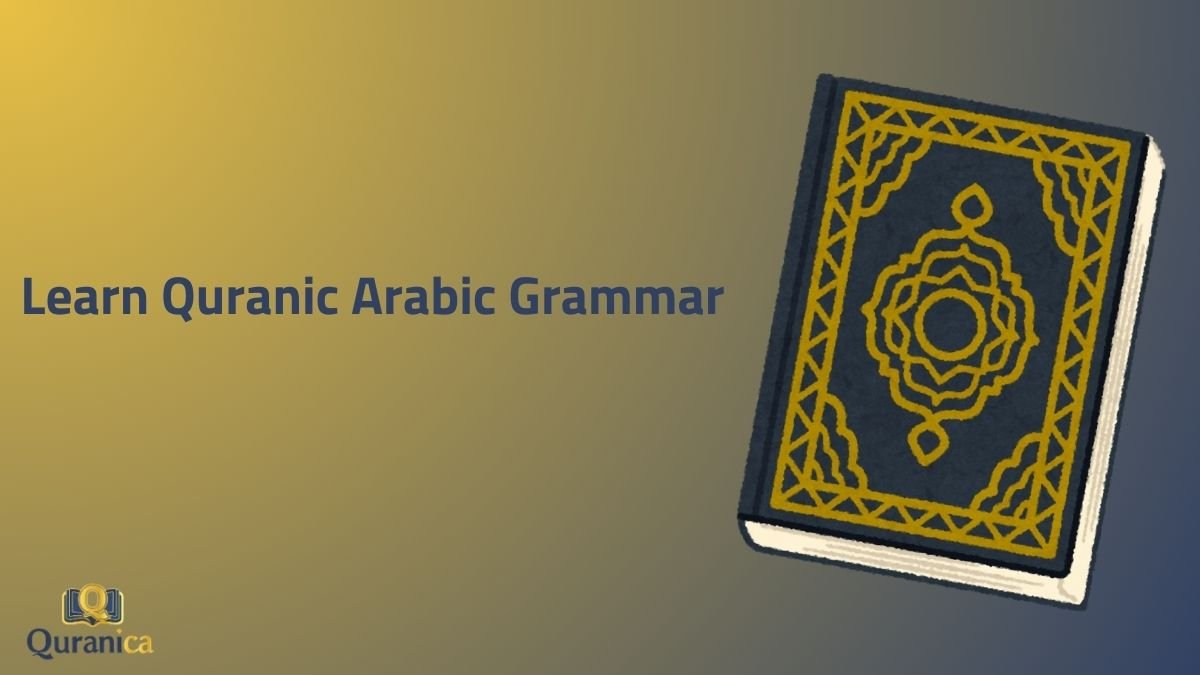In A Nutshell: Quranic Arabic Grammar governs how words form and connect in the Quran, shaping meaning through sentence structure, verb conjugation, and case endings. Nominal sentences describe states, while verbal ones emphasize action. Nouns vary by gender and number, while verbs shift with tense and subject. Key particles like prepositions, conjunctions, and interrogatives refine meaning, and I‘rab (case endings) define word roles.
Just like any language, Arabic has its own rules and its own way of putting words together to make sense. This system of rules, when we talk about the Arabic in the Quran, we called Quranic Arabic Grammar.
If you learn even the essentials of this Quranic Arabic grammar, Insha’Allah, your connection with the Quran will become much stronger.
So, where do we start learning Quranic Arabic grammar in English? What are the most important things to learn in Quranic Arabic Grammar that will help you on your path to understanding the Quran? Let’s talk about some essential Quranic Arabic Grammar lessons.
What is Quranic Arabic Grammar?
Simply, Quranic Arabic Grammar is essentially the science of understanding how Arabic words are formed and how they connect together to create meaningful Quranic sentences.
Now, let’s go through some of the most important lessons in Quranic Arabic Grammar that will help you to start your path.
Basic Sentence Structure in Quranic Arabic
First, you need to know how sentences are usually formed in Quranic Arabic.
In English, you often start with the subject, then the verb, then the object. For example, “Ali read the book”.
But in Arabic, sentences can start with either a verb or a noun.
1. Nominal Sentences in Quranic Arabic (الجملة الاسمية – Al-Jumlatul Ismiyyah)
If the sentence starts with a noun, we call it a nominal sentence (جملة اسمية – jumla ismiyya). Nominal sentences usually tell us about the state or condition of something. For example:
“وَاللَّهُ غَفُورٌ رَّحِيمٌ”
(Wallahu Ghafoorun Raheemun)
“And Allah is Forgiving and Merciful”. (al-Baqara 2:218)
Here, ٱللَّهُ (Allahu – Allah) is the subject, and غَفُورٌ (Ghafoorun – Forgiving) and رَّحِيمٌ (Raheemun – Merciful) are both predicates describing Allah (SWT).
2. Verbal Sentences in Quranic Arabic (الجملة الفعلية – Al-Jumlatul Fi’liyyah)
If the sentence starts with a verb, we call it a verbal sentence (جملة فعلية – jumla fi’liyya). Let’s see an example from the Quran where Allah tells us about what He does:
“يُدَبِّرُ الْأَمْرَ”
(yudabbiru alamra)
“He arranges [each] matter” (Surah Ar-Ra’d, 13:2)
يُدَبِّرُ (yudabbiru – He arranges) is the verb at the beginning, followed by the object الْأَمْرَ (alamra – matter).
Ans a clearer example is:
“ضَرَبَ ٱللَّهُ مَثَلًا”
(Darab allahu mathala)
“Allah presents an example”. (Az-Zumur 39:29)
Here, “ضَرَبَ” (Daraba) is the verb (past tense, “presented”), “ٱللَّهُ” (Allahu) is the subject (who presented, Allah), and “مَثَلًا” (mathala) is the object (what was presented, an example).
Understanding this basic difference between verbal and nominal sentences is the first step in understanding Quranic Arabic Grammar.
At Quranica, our Quranic Arabic course will guide you step-by-step to easily recognize these structures in the Quran.
Nouns in Quranic Arabic Grammar
In Quranic Arabic Grammar, nouns have characteristics that you need to learn following your overall comprehension of sentence structure in Quranic grammar.
1. Nouns Have Gender in Quranic Arabic Grammar
One important thing is that nouns have gender: they can be masculine (مذكر – mudhakkar) or feminine (مؤنث – mu’annath).
There are signs that can help you identify feminine Arabic nouns. One common sign is the ending (ـة – ah or t sound), like in the word جَنَّة (jannah – paradise):
“تِلْكَ الْجَنَّةُ الَّتِي نُورِثُ مِنْ عِبَادِنَا مَن كَانَ تَقِيًّا”
(Tilka aljannatu allatee noorithu min AAibadina man kana taqiyyan)
“That is Paradise, which We give as inheritance to those of Our servants who were fearing of Allah.” (Surah Maryam, 19:63)
Read more about: How to Learn Quranic Arabic? A 7-Step Guide
2. Quranic Arabic has Singular, DUAL, and Plural Forms for Nouns
Another important characteristic of Arabic nouns is their number: they can be singular (مفرد – mufrad), dual (مثنى – muthannā), or plural (جمع – jam’un). The Quran uses all these forms.
For example, the word رَجُل (rajul – a man) is singular. If you want to say two men, it becomes رَجُلَانِ (rajulāni):
“قَالَ رَجُلَانِ مِنَ ٱلَّذِينَ يَخَافُونَ أَنۡعَمَ ٱللَّهُ عَلَيۡهِمَا ٱدۡخُلُواْ عَلَيۡهِمُ ٱلۡبَابَ“
(Qāla rajulāni minal-lażīna yakhāfūna an‘amallāhu ‘alaihima)
“Said two men from those who feared [to disobey] upon whom Allah had bestowed favor” (Surah Al-Ma’idah, 5:23)
And for more than two men, it can be رِجَال (rijāl):
“رِجَالٌ لَّا تُلۡهِيهِمۡ تِجَـٰرَةٌ وَلَا بَيۡعٌ عَن ذِكۡرِ ٱللَّهِ“
(Rijālul lā tul’hīhim tijāratuw wa lā bai‘un ‘an żikrillāhi)
“Men whom neither trade nor sale distracts from the remembrance of Allah” (Surah An-Nur, 24:37)
Our native Arab teachers at Quranica are experts in explaining these concepts with easy-to-understand methods.
Read more about: Top 10 Quranic Arabic Books
Tenses of Verbs in Quranic Arabic
The three main tenses in In Quranic Arabic grammar are the past tense (maadhi), the present/future tense (mudhari), and the command tense (amr) .
For example, “فَتَحْنَا أَبْوَابَ السَّمَاءِ بِمَاءٍ مُّنْهَمِرٍ“ means “So We opened (Fatahna) the gates of the sky with rain pouring down” . The verb فَتَحْ (Fataha) means “opened.” The “na” at the end shows that the subject is “We” (referring to Allah, in His majestic plural form). This past tense verb describes a decisive action that has already taken place.
For the present/future tense, we have verbs like “يَخْلُقُ” (Yakhluqu) means “He creates”. We see this in the verse “وَيَخْلُقُ مَا لَا تَعْلَمُونَ” (Wa yakhluqu ma la ta’lamoon) (And He creates that which you do not know).
And for the command tense, we have “إِقْرَأْ بِٱسْمِ رَبِّكَ” (iqra’ bismi rabbika) meaning “Read! In the Name of your Lord” . “إِقْرَأْ” (iqra’) is a verb in the command tense.
Focus on Arabic Verb Conjugation First
I briefly touched on tenses because the Arabic verb conjugation deserves more attention from you first.
The way verbs change in Arabic based on the subject (who is doing the action) is systematic. By learning these patterns, you can quickly understand who is being referred to in a verse.
For example, let’s take the verb سَمِعَ (sami‘a – he heard). It conjugates as follows in the past tense:
- I heard: سَمِعۡتُ (sami‘tu)
- You (male singular) heard: سَمِعۡتَ (sami‘ta)
- You (female singular) heard: سَمِعۡتِ (sami‘ti)
- He heard: سَمِعَ (sami‘a)
- She heard: سَمِعَتۡ (sami‘at)
- We heard: سَمِعۡنَا (sami‘nā)
- You (dual) heard: سَمِعۡتُمَا (sami‘tumā)
- You (male plural) heard: سَمِعۡتُمۡ (sami‘tum)
- You (female plural) heard: سَمِعۡتُنَّ (sami‘tunna)
- They (dual) heard: سَمِعَا (sami‘ā)
- They (male plural) heard: سَمِعُواْ (sami‘ū)
- They (female plural) heard: سَمِعۡنَ (sami‘na)
And the verb conjugates differently in the present/future tense.
Learning these conjugations might seem like a lot at first, but Quranica breaks it down into manageable lessons with plenty of practice.
Once you start recognizing these patterns, your ability to understand the tenses will increase.
The Roles of Particles in Quranic Arabic Grammar
In Quranic Arabic grammar, there are many types of particles, such as prepositions (حروف الجر – huroof al-jarr), conjunctions (حروف العطف – huroof al-‘aṭf), and particles of negation (حروف النفي – huroof an-nafy).
1. Prepositions in Quranic Arabic Grammar
Prepositions show the relationship between nouns, like فِي (fī – in), عَلَىٰ (‘alā – on), إِلَىٰ (ilā – to), and مِن (min – from). For example, in the verse:
“سُبْحَانَ الَّذِي أَسْرَىٰ بِعَبْدِهِ لَيْلًا مِنَ الْمَسْجِدِ الْحَرَامِ إِلَى الْمَسْجِدِ الْأَقْصَى”
(Subhāna alladhī asrā bi’abdihi laylan mina al-masjidi al-harāmi ilā al-masjidi al-aqsā)
“Exalted is He who took His Servant by night from al-Masjid al-Haram to al-Masjid al-Aqsa…” (Surah Al-Isra, 17:1)
As you see, “مِنَ” (min) and “إِلَى” (ilā) show the starting and ending points of the miraculous journey.
2. Conjunctions in Quranic Arabic Grammar
Conjunctions connect words or sentences, like وَ (wa – and), أَوۡ (aw – or), and ثُمَّ (thumma – then). Example using وَ (wa – and) where the “وَ” (wa) connects two commands:
“كُلُوا مِنْ ثَمَرِهِ إِذَا أَثْمَرَ وَآتُوا حَقَّهُ يَوْمَ حَصَادِهِ”
(Kulū min thamarihi idhā athmara wa ātū haqqahu yawma hasādih)
“Eat of its fruit when it yields fruit and give its due [zakat] on the day of its harvest” (Surah Al-An’am, 6:141)
3. Interrogative Particles in Quranic Arabic Grammar
These make a sentence a question.
- أَ (a) – “Is…?” “Does…?” (a yes/no question)
- هَلْ (hal) – Similar to “أ”
- مَنْ (man) – “Who?”
- مَا (mā) – “What?”
- مَتَى (matā) – “When?”
- أَيْنَ (ayna) – “Where?”
- كَيْفَ (kayfa) – “How?”
- كَمْ (kam) – “How many/much?”
“أَفَلَا يَتَدَبَّرُونَ الْقُرْآنَ”
(Afalā yatadabbarūna al-Qur’ān)
“Then do they not reflect upon the Quran?” (Surah An-Nisa, 4:82)
The أَ (a) at the beginning makes this a question. “But here, it is a rhetorical question, not a literal one.
Case Endings (I’rab) to Master Quranic Grammar Analysis
Understanding I’rab is like having a key that unlocks the meaning of Quranic sentences. By recognizing the case endings (the vowels at the end of words), you can identify the role of each word – is it the subject, the object, or something else? This is essential for accurate Quranic grammar analysis.
Let’s look at some clear examples directly from the Quran:
1. The Nominative Case in Quranic Grammar Analysis
The nominative case usually shows the subject of the sentence (the one doing the action). The basic ending for a singular noun in Raf’ is “-un” (ـٌ) or “-u” (ـُ) if it has Alif Lam (the definite article “the”).
“ٱللَّهُ نُورُ ٱلسَّمَـٰوَاتِ وَٱلْأَرْضِ”
(Allahu nurus-samawati wal-ard)
“Allah is the light of the heavens and the earth”. (Surat al-Noor 24:35)
“ٱللَّهُ” (Allahu) ends with “-u” and it is the subject of the sentence. It is in the Raf’ case.
2. The Accusative Case in Quranic Grammar Analysis
The accusative case often shows the object of the verb (the one receiving the action). The basic ending for a singular noun in Nasb is “-an” (ـً) or “-a” (ـَ) with Alif Lam.
“إِنَّ ٱللَّهَ يَغْفِرُ ٱلذُّنُوبَ جَمِيعًا”
“Inna Allaha yaghfiru adh-dhunuba jami’a”
“Indeed, Allah forgives all sins”. (Az-Zumar 39:35)
Here, “ٱللَّهَ” (Allaha) ends with “-a” because of “إِنَّ” (Inna), a particle that puts the following noun in Nasb.
Also, “ٱلذُّنُوبَ” (adh-dhunuba) ends with “-a” as it is the object of the verb “يَغْفِرُ” (yaghfiru, forgives).
3. The Genitive Case in Quranic Grammar Analysis
The genitive case usually comes after a preposition or in a possessive construction (like “the book of Muhammad”). The basic ending for a singular noun in Jarr is “-in” (ـٍ) or “-i” (ـِ) with Alif Lam.
“لِلَّهِ مُلْكُ ٱلسَّمَـٰوَاتِ وَٱلْأَرْضِ”
“ Lillahi mulkus-samawati wal-ardi”
“To Allah belongs the dominion of the heavens and the earth”. (Aal-i-Imran 3:189)
Here, “لِلَّهِ” (Lillahi) ends with “-i” because of the preposition “لِـ” (Li-, to).
Also, “ٱلْأَرْضِ” (al-ard) ends with “-i” because it comes after the preposition “وَ” (wa, and) which connects it to “ٱلسَّمَـٰوَاتِ” (as-samawati) which is also in Jarr because of the possessive structure “مُلْكُ ٱلسَّمَـٰوَاتِ” (mulkus-samawati, the dominion of the heavens).
Understanding these cases is very important for knowing who is doing what in the sentence and the relationships between the words.
In our Quranica Grammar Course, we delve deeper into the different reasons why a noun might be in Raf’, Nasb, or Jarr, including the effects of different particles and sentence structures.
Quranica Can Help You Master Quranic Arabic Grammar
My dear brothers and sisters, these are just some of the important lessons in Quranic Arabic grammar that will help you in your journey to understanding the Quran.
It might seem like a lot, but believe me, with the right guidance and consistent effort, it is definitely achievable.
And that’s where Quranica can truly help you.
We offer structured courses designed to teach you Quranic Arabic grammar in a way that is easy to understand for non-Arabic speakers.
- We focus on grammar that help you read Quran ASAP – no wasting time
- We use frequency-based approach – learn most common patterns first.
- We connect everything to Quran verses you will encounter.
Our native Arab experienced teachers, who are also Huffaz (memorizers of the Quran), use practical methods and clear explanations to guide you through each concept.
You will learn at your own pace, with interactive exercises and real examples from the Quran.
Take the first step today and JOIN Quranica.
Conclusion:
Quranic Arabic Grammar is the structured system of rules governing how words are formed and combined in the Quran. Mastering its basics strengthens one’s connection with the Quran, allowing for deeper comprehension. A fundamental aspect of Quranic Arabic is understanding sentence structures—nominal sentences (starting with a noun) describe states, while verbal sentences (beginning with a verb) emphasize actions.
Nouns in Quranic Arabic have gender (masculine or feminine) and number (singular, dual, or plural), affecting sentence construction. Verbs change based on tense (past, present/future, and command) and subject pronouns, following systematic conjugation patterns.
Another crucial element is recognizing particles, including prepositions (e.g., “في” meaning “in”), conjunctions (“وَ” meaning “and”), and interrogative words (e.g., “مَنْ” for “who?”). These elements shape sentence meaning. Case endings (I‘rab) help determine a word’s role in a sentence—whether as a subject (nominative case), object (accusative case), or part of a prepositional phrase (genitive case).








0 Comments